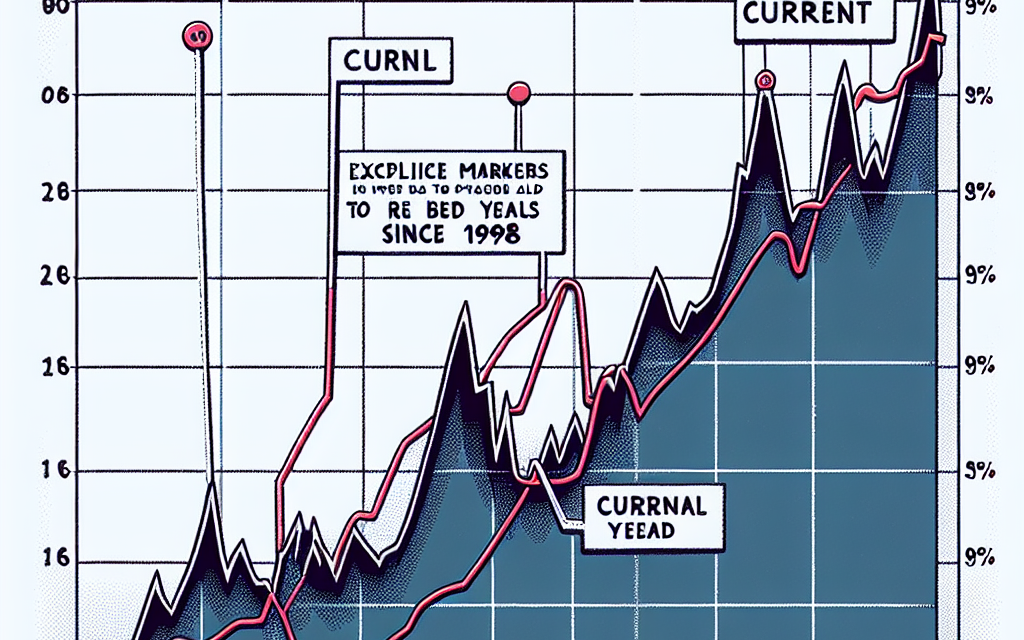“U.K. Bond Yields Surge to 25-Year Highs: A New Era of Investment Returns.”
Introduction
U.K. bond yields have surged to their highest levels since 1998, reflecting a significant shift in the financial landscape. This increase is driven by a combination of factors, including rising inflation expectations, changes in monetary policy, and market reactions to economic data. As investors reassess the risk and return dynamics of government debt, the implications for borrowing costs, investment strategies, and overall economic growth are becoming increasingly pronounced. The rise in yields signals a pivotal moment for the U.K. economy, influencing everything from mortgage rates to government financing.
U.K. Bond Yields: Historical Context and Current Trends
In recent months, U.K. bond yields have surged to their highest levels since 1998, prompting a reevaluation of the economic landscape and investor sentiment. To understand the significance of this development, it is essential to consider the historical context of bond yields in the U.K. and the factors contributing to the current trends. Historically, bond yields have served as a barometer for economic health, reflecting investor confidence and expectations regarding inflation, interest rates, and overall economic growth. In the late 1990s, yields were influenced by a combination of robust economic performance and the Bank of England’s monetary policy aimed at controlling inflation. As the economy expanded, yields rose, peaking in the late 1990s before entering a prolonged period of decline.
Fast forward to the present, the recent spike in U.K. bond yields can be attributed to a confluence of factors, including rising inflation, shifts in monetary policy, and global economic uncertainties. Inflation, which has been a growing concern for many economies worldwide, has reached levels not seen in decades. In the U.K., this has been exacerbated by supply chain disruptions, energy price surges, and the lingering effects of the COVID-19 pandemic. As inflation expectations rise, investors demand higher yields to compensate for the eroding purchasing power of fixed-income investments. Consequently, the yield on 10-year government bonds has climbed significantly, reflecting these heightened inflationary pressures.
Moreover, the Bank of England’s response to inflation has also played a crucial role in shaping bond yields. As central banks globally pivot towards tightening monetary policy, the U.K. is no exception. The Bank of England has signaled its intention to raise interest rates in an effort to combat inflation, which has further influenced bond yields. When interest rates rise, newly issued bonds typically offer higher yields, leading to a decrease in the prices of existing bonds. This inverse relationship between bond prices and yields has been evident in the recent market dynamics, as investors adjust their portfolios in anticipation of a more aggressive monetary stance.
In addition to domestic factors, global economic trends have also impacted U.K. bond yields. The interconnectedness of financial markets means that developments in other major economies, particularly the United States, can have ripple effects on U.K. yields. As the U.S. Federal Reserve has taken steps to taper its asset purchases and signal potential rate hikes, investors have recalibrated their expectations for global interest rates. This has led to a reassessment of risk and return across various asset classes, including U.K. government bonds.
As we look ahead, the trajectory of U.K. bond yields will likely remain influenced by ongoing economic developments, both domestically and internationally. Investors will be closely monitoring inflation data, central bank communications, and geopolitical events that could sway market sentiment. The current environment presents a complex landscape for fixed-income investors, as they navigate the challenges posed by rising yields while seeking opportunities in a changing economic climate. Ultimately, the recent rise in U.K. bond yields serves as a reminder of the dynamic nature of financial markets and the importance of understanding historical trends to inform future investment decisions.
Impact of Rising Bond Yields on the U.K. Economy
The recent surge in U.K. bond yields, reaching levels not seen since 1998, has significant implications for the broader economy. As bond yields rise, they reflect increasing borrowing costs for the government, which can lead to a tightening of fiscal policy. This situation arises because higher yields typically indicate that investors demand greater compensation for the perceived risk of lending to the government. Consequently, the U.K. Treasury may face pressure to adjust its spending and borrowing strategies, potentially leading to cuts in public services or infrastructure projects that are vital for economic growth.
Moreover, rising bond yields can influence the behavior of consumers and businesses alike. When government borrowing costs increase, it often leads to higher interest rates across the economy. For consumers, this translates into more expensive loans for mortgages, car purchases, and credit cards. As borrowing becomes costlier, consumer spending may decline, which is a critical driver of economic growth. A decrease in consumer confidence can create a ripple effect, leading to reduced demand for goods and services, ultimately impacting businesses and their investment decisions.
In addition to consumer behavior, businesses may also reassess their investment strategies in response to rising bond yields. Higher yields can lead to increased costs of financing for companies that rely on debt to fund expansion or operational activities. As a result, businesses may delay or scale back investment plans, which can stifle innovation and productivity growth. This cautious approach can hinder the overall economic momentum, as businesses play a crucial role in job creation and wage growth.
Furthermore, the implications of rising bond yields extend to the housing market. As mortgage rates climb in tandem with bond yields, potential homebuyers may find themselves priced out of the market. This situation can lead to a slowdown in housing transactions, which not only affects the real estate sector but also has broader implications for related industries, such as construction and home improvement. A sluggish housing market can dampen consumer wealth, as property values may stagnate or decline, further impacting consumer spending.
The financial markets are also sensitive to changes in bond yields. As yields rise, investors may shift their portfolios, moving away from equities and into fixed-income securities. This shift can lead to increased volatility in stock markets, as capital flows adjust in response to changing perceptions of risk and return. Such volatility can create uncertainty for businesses and consumers alike, potentially leading to a more cautious economic environment.
In the context of international markets, rising U.K. bond yields can also affect the value of the British pound. As yields increase, the currency may strengthen due to higher returns on investments denominated in pounds. While a stronger pound can benefit consumers by making imports cheaper, it can also pose challenges for exporters, who may find their goods less competitive in global markets. This dynamic can further complicate the economic landscape, as the balance between domestic consumption and international trade becomes increasingly delicate.
In summary, the rise in U.K. bond yields to their highest levels since 1998 carries profound implications for the economy. From influencing government fiscal policy to affecting consumer behavior and business investment, the interconnectedness of these factors underscores the importance of monitoring bond yields as a key economic indicator. As the situation evolves, stakeholders across the economy will need to navigate the challenges and opportunities presented by this significant shift in the financial landscape.
Investor Sentiment: Navigating High Bond Yields
As U.K. bond yields reach their highest levels since 1998, investor sentiment is undergoing a significant transformation. The surge in yields, driven by a combination of factors including rising inflation expectations and shifts in monetary policy, has prompted investors to reassess their strategies in the fixed-income market. This environment presents both challenges and opportunities, compelling market participants to navigate the complexities of high bond yields with a keen understanding of the underlying economic landscape.
In recent months, the Bank of England has signaled a more hawkish stance, responding to persistent inflationary pressures that have emerged in the wake of global supply chain disruptions and increased consumer demand. As central banks around the world grapple with the dual mandate of fostering economic growth while controlling inflation, the U.K. has found itself at a crossroads. The implications of these policy shifts are profound, as higher interest rates typically lead to increased bond yields, which inversely affect bond prices. Consequently, investors are faced with the dilemma of whether to hold onto existing bonds or to seek new opportunities in a rapidly changing market.
Moreover, the rising yields have sparked a broader conversation about the attractiveness of fixed-income investments relative to equities and other asset classes. Historically, bonds have been viewed as a safe haven, providing stability and income during periods of market volatility. However, as yields climb, the risk-reward profile of bonds is evolving. Investors are now weighing the potential for capital appreciation in equities against the income generation capabilities of bonds, leading to a more nuanced approach to portfolio allocation. This shift in sentiment is particularly evident among institutional investors, who are increasingly diversifying their holdings to mitigate risks associated with rising yields.
In addition to the macroeconomic factors influencing bond yields, geopolitical events and market sentiment also play a crucial role in shaping investor behavior. The ongoing uncertainty surrounding global trade dynamics and geopolitical tensions can lead to fluctuations in investor confidence, prompting a flight to safety or a willingness to embrace riskier assets. As such, understanding the interplay between these factors is essential for investors seeking to navigate the current landscape of high bond yields.
Furthermore, the implications of rising yields extend beyond traditional fixed-income investors. Retail investors, who may have relied on bonds for income generation, are now confronted with the reality of lower returns in a higher yield environment. This has led many to explore alternative investment strategies, such as dividend-paying stocks or real estate investment trusts (REITs), which may offer more attractive yields in comparison to traditional bonds. As investors adapt to these changing dynamics, the importance of thorough research and strategic planning cannot be overstated.
In conclusion, the recent rise in U.K. bond yields marks a pivotal moment for investor sentiment, prompting a reevaluation of fixed-income strategies in light of evolving economic conditions. As market participants grapple with the implications of higher yields, the need for a diversified and well-informed investment approach becomes increasingly critical. By staying attuned to macroeconomic trends, geopolitical developments, and shifts in market sentiment, investors can better position themselves to navigate the complexities of this new landscape, ultimately enhancing their potential for long-term success in an environment characterized by uncertainty and change.
The Role of Inflation in U.K. Bond Yield Increases
In recent months, U.K. bond yields have surged to their highest levels since 1998, a development that has captured the attention of investors and economists alike. This significant increase can be largely attributed to the persistent inflationary pressures that have gripped the economy. As inflation rises, the real return on bonds diminishes, prompting investors to demand higher yields to compensate for the erosion of purchasing power. Consequently, the interplay between inflation and bond yields has become a focal point in understanding the current financial landscape.
To begin with, it is essential to recognize that inflation reflects the rate at which the general level of prices for goods and services is rising. In the U.K., inflation has been driven by various factors, including supply chain disruptions, increased energy costs, and robust consumer demand as the economy rebounds from the pandemic. As these pressures have intensified, the Bank of England has been compelled to respond, adjusting its monetary policy to mitigate the effects of rising prices. This response has included discussions around interest rate hikes, which further influence bond yields.
As inflation expectations rise, investors begin to reassess the attractiveness of fixed-income securities. When inflation is anticipated to outpace the nominal yield on bonds, the real yield—the yield adjusted for inflation—becomes less appealing. This scenario leads to a sell-off in bonds, pushing yields higher as prices fall. The recent spike in U.K. bond yields can thus be seen as a market reaction to the growing consensus that inflation will remain elevated for an extended period. Investors are recalibrating their portfolios, seeking to protect their investments from the diminishing value of money.
Moreover, the relationship between inflation and bond yields is not merely a short-term phenomenon; it has long-term implications for fiscal policy and economic growth. As yields rise, borrowing costs for the government and private sector increase, which can dampen economic activity. Higher yields may lead to reduced consumer spending and business investment, as financing becomes more expensive. This dynamic creates a feedback loop where rising yields can further exacerbate inflationary pressures, as the cost of goods and services continues to climb in response to increased borrowing costs.
In addition to these economic considerations, geopolitical factors also play a crucial role in shaping inflation and bond yields. The ongoing conflict in Ukraine, for instance, has contributed to volatility in energy prices, which in turn affects inflation rates across Europe, including the U.K. As global supply chains remain under strain, the uncertainty surrounding commodity prices adds another layer of complexity to the inflation narrative. Investors are acutely aware of these external factors, which can lead to fluctuations in bond yields as market sentiment shifts in response to new information.
In conclusion, the recent rise in U.K. bond yields to their highest levels since 1998 is intricately linked to the prevailing inflationary environment. As inflation continues to challenge economic stability, the demand for higher yields reflects investors’ need for compensation against the backdrop of eroding purchasing power. This situation not only influences individual investment decisions but also has broader implications for economic growth and fiscal policy. As the U.K. navigates these turbulent waters, the interplay between inflation and bond yields will remain a critical area of focus for policymakers and market participants alike.
Comparing U.K. Bond Yields to Global Markets
In recent months, U.K. bond yields have surged to their highest levels since 1998, prompting a closer examination of their implications within the broader context of global financial markets. This significant increase in yields reflects a complex interplay of factors, including rising inflation expectations, shifts in monetary policy, and evolving investor sentiment. As the Bank of England navigates the challenges posed by a volatile economic landscape, the implications of these rising yields extend beyond the U.K. borders, influencing global market dynamics.
To begin with, the rise in U.K. bond yields can be attributed to a combination of domestic and international pressures. Domestically, the Bank of England has signaled a more aggressive stance on interest rates in response to persistent inflationary pressures. As inflation rates climb, investors demand higher yields to compensate for the eroding purchasing power of fixed-income investments. This trend is not isolated to the U.K.; similar patterns are observable in other major economies, where central banks are also grappling with inflationary challenges. For instance, the U.S. Federal Reserve has adopted a hawkish tone, leading to increased yields on U.S. Treasuries. Consequently, the interconnectedness of global markets means that movements in U.K. bond yields resonate with investors worldwide.
Moreover, the rising yields in the U.K. have implications for currency markets as well. As bond yields increase, they often attract foreign investment, leading to an appreciation of the British pound. This phenomenon can be observed in the context of the U.S. dollar, which has experienced fluctuations as investors weigh the relative attractiveness of U.K. assets against those in the U.S. and other regions. The interplay between bond yields and currency values underscores the importance of monitoring global economic indicators, as shifts in one market can have cascading effects across others.
In addition to currency implications, the rise in U.K. bond yields has significant ramifications for equity markets. Higher yields typically signal a more challenging environment for equities, as the cost of borrowing increases and corporate financing becomes more expensive. Investors may reassess their portfolios, shifting capital away from equities and into fixed-income securities that now offer more attractive returns. This shift can lead to increased volatility in stock markets, as seen in recent trading sessions where U.K. equities have reacted to the changing yield landscape. The correlation between bond yields and equity performance highlights the delicate balance that investors must navigate in a rapidly evolving financial environment.
Furthermore, the global context of rising bond yields cannot be overlooked. Countries across Europe and Asia are experiencing similar trends, as central banks respond to inflationary pressures and economic recovery post-pandemic. The synchronization of these movements suggests a broader shift in monetary policy that could redefine investment strategies worldwide. As investors recalibrate their expectations, the potential for increased market volatility looms large, necessitating a careful assessment of risk and return across asset classes.
In conclusion, the recent surge in U.K. bond yields to their highest levels since 1998 serves as a critical indicator of shifting economic conditions both domestically and globally. As investors navigate this complex landscape, the interplay between bond yields, currency values, and equity performance will continue to shape market dynamics. Understanding these relationships is essential for making informed investment decisions in an increasingly interconnected world, where the implications of local developments resonate on a global scale.
Future Projections for U.K. Bond Yields
As U.K. bond yields reach their highest levels since 1998, the implications for future projections are becoming increasingly significant for investors, policymakers, and the broader economy. The recent surge in yields can be attributed to a combination of factors, including rising inflation expectations, shifts in monetary policy, and global economic uncertainties. As these dynamics continue to evolve, understanding the potential trajectory of U.K. bond yields is essential for making informed financial decisions.
In the short term, analysts anticipate that bond yields may remain elevated as the Bank of England grapples with the challenge of curbing inflation while supporting economic growth. The central bank’s recent signals regarding interest rate hikes suggest a commitment to addressing inflationary pressures, which could further influence bond yields. If the Bank of England continues to raise rates, it is likely that yields will respond accordingly, reflecting the increased cost of borrowing and the market’s expectations for future economic conditions.
Moreover, the global economic landscape plays a crucial role in shaping U.K. bond yields. As central banks around the world, particularly in the United States and the Eurozone, adjust their monetary policies in response to inflationary trends, the interconnectedness of global markets means that U.K. yields will be influenced by these developments. For instance, if the Federal Reserve continues to tighten its monetary policy, it could lead to capital outflows from the U.K., putting upward pressure on yields as investors seek higher returns elsewhere. Conversely, if global economic conditions deteriorate, there may be a flight to safety, resulting in increased demand for U.K. government bonds and potentially lowering yields.
In addition to these macroeconomic factors, domestic political developments will also play a pivotal role in shaping future bond yield projections. The U.K. government’s fiscal policies, including spending and taxation decisions, can significantly impact investor sentiment and, consequently, bond yields. For example, if the government pursues a strategy of increased public spending without a clear plan for fiscal sustainability, it could raise concerns about the country’s debt levels, leading to higher yields as investors demand a premium for perceived risk.
Furthermore, the ongoing effects of Brexit continue to create uncertainty in the U.K. economy, which may influence bond yields in the coming years. As trade relationships evolve and the U.K. navigates its post-Brexit landscape, the potential for economic volatility could lead to fluctuations in bond yields. Investors will be closely monitoring developments in trade agreements and regulatory changes, as these factors could either bolster or undermine confidence in U.K. assets.
Looking further ahead, some analysts suggest that while current yields may remain high, there is potential for stabilization as the market adjusts to the new economic realities. If inflationary pressures begin to ease and the Bank of England successfully manages its monetary policy, yields could stabilize at lower levels. However, this scenario hinges on a delicate balance of economic growth, inflation control, and investor confidence.
In conclusion, the future projections for U.K. bond yields are shaped by a complex interplay of domestic and global factors. As the landscape continues to evolve, investors must remain vigilant and adaptable, recognizing that the trajectory of bond yields will be influenced by a myriad of economic indicators and policy decisions. Understanding these dynamics will be crucial for navigating the challenges and opportunities that lie ahead in the bond market.
Strategies for Investors Amidst High Bond Yields
As U.K. bond yields reach their highest levels since 1998, investors are faced with a unique set of challenges and opportunities. The surge in yields, driven by a combination of rising inflation expectations and central bank policy adjustments, has created a complex landscape for fixed-income investments. In this environment, it is crucial for investors to adopt strategies that not only mitigate risks but also capitalize on potential returns.
One of the primary strategies for investors is to reassess their bond portfolios. With yields climbing, the prices of existing bonds are likely to decline, which can lead to capital losses for those holding long-duration bonds. Therefore, investors may consider shortening the duration of their bond holdings. By focusing on shorter-term bonds, investors can reduce their exposure to interest rate risk while still benefiting from the higher yields available in the current market. This approach allows for greater flexibility, enabling investors to reinvest in new bonds as rates continue to fluctuate.
In addition to adjusting duration, diversifying bond holdings can also be an effective strategy. Investors should explore a mix of government bonds, corporate bonds, and high-yield bonds to spread risk across different sectors. While government bonds are generally considered safer, corporate bonds may offer higher yields, albeit with increased risk. By diversifying, investors can potentially enhance their overall returns while managing the risks associated with any single bond type.
Moreover, it is essential for investors to stay informed about macroeconomic indicators and central bank policies. The Bank of England’s decisions regarding interest rates and quantitative easing will significantly impact bond yields. By closely monitoring these developments, investors can make more informed decisions about when to enter or exit positions in the bond market. For instance, if inflation continues to rise, the central bank may be compelled to increase interest rates further, which could lead to additional increases in bond yields. Understanding these dynamics can help investors time their investments more effectively.
Another strategy worth considering is the use of bond funds or exchange-traded funds (ETFs). These investment vehicles provide instant diversification and professional management, which can be particularly beneficial in a volatile market. Bond funds can offer exposure to a wide range of bonds, including those with varying maturities and credit qualities. This can help investors navigate the complexities of the bond market without having to manage individual securities themselves.
Furthermore, investors should not overlook the potential of alternative investments. In a high-yield environment, assets such as real estate investment trusts (REITs), infrastructure funds, and commodities may provide attractive returns that can complement a traditional bond portfolio. These alternatives can serve as a hedge against inflation and may offer income streams that are less correlated with bond yields.
In conclusion, as U.K. bond yields reach their highest levels since 1998, investors must adopt a proactive approach to navigate this challenging landscape. By reassessing bond portfolios, diversifying holdings, staying informed about economic indicators, considering bond funds, and exploring alternative investments, investors can position themselves to not only weather the storm but also seize opportunities that arise in this evolving market. Ultimately, a well-thought-out strategy will be essential for achieving long-term financial goals amidst the shifting dynamics of bond yields.
Q&A
1. **What are UK bond yields?**
UK bond yields are the interest rates paid by the government on its debt securities, reflecting the return investors can expect from holding these bonds.
2. **Why have UK bond yields reached their highest levels since 1998?**
Factors include rising inflation, expectations of interest rate hikes by the Bank of England, and increased government borrowing.
3. **What impact do rising bond yields have on the economy?**
Higher bond yields can lead to increased borrowing costs for the government and consumers, potentially slowing economic growth.
4. **How do UK bond yields compare to other countries?**
UK bond yields may be higher than those of other developed countries, reflecting specific economic conditions and investor sentiment in the UK.
5. **What does a rise in bond yields indicate about investor confidence?**
A rise in bond yields can indicate that investors are concerned about inflation and are demanding higher returns for holding government debt.
6. **How do rising bond yields affect mortgage rates?**
Rising bond yields often lead to higher mortgage rates, as lenders adjust their rates based on the cost of borrowing in the bond market.
7. **What are the potential long-term effects of sustained high bond yields?**
Sustained high bond yields could lead to tighter financial conditions, reduced consumer spending, and slower economic growth over time.
Conclusion
U.K. bond yields reaching their highest levels since 1998 indicates a significant shift in the financial landscape, driven by factors such as rising inflation expectations, changes in monetary policy, and increased government borrowing. This trend reflects growing investor concerns about economic stability and the potential for higher interest rates, which could impact borrowing costs and overall economic growth. The elevated yields may also signal a reassessment of risk in the bond market, influencing investment strategies and financial planning moving forward.





